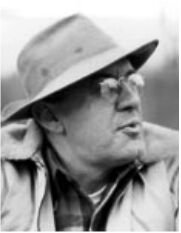
Howard Zahniser
February 25, 1906 - May 5, 1964Howard Zahniser was born on February 25, 1906, in Franklin, Pennsylvania. Howard grew up in the Allegheny River region of Northwestern Pennsylvania. He found his love for nature and the beauty of wilderness as a teenager in the town Tionesta, located just west of what is now the Allegheny National Forest. Howard attended Greenville College in Illinois and received a degree in humanities. He obtained his master’s degree at George Washington University, but did not write the degree thesis. In 1959, Zahniser received an honorary Doctor of Letters from his alma mater. He spent his post graduate career teaching at a school while working as a newspaper reporter. But none of this made him truly happy.
In 1930, Zahniser began working with the U.S. Department of Commerce. Advancing within the government, he was later employed by the USDA Bureau of Biological Survey (known today as the Fish and Wildlife Service). He spent 12 years working in the information division for the Fish and Wildlife service. During these 12 years, he experienced a similar feeling he had as a teenager exploring the Alleghany wilderness. Influenced by professionals such as Ira Gabrielson and Edward Preble whom were both conservationists and naturalists, he began performing his own research, writing, and editing. When the Fish and Wildlife Service relocated to Chicago, Howard found work in the USDA Bureau of Plant Industry, Soils, and Agricultural Engineering.
As a federal employee, Howard supplied articles and essays to scholars and scientific journals involving the conservation and environmentalism movement, specifically focused on ecosystems and wilderness. His ideas of ecosystems and wilderness were influenced by colleagues such as Harvey Broome, Aldo Leopold, Ernest Oberholtzer, and Olas Johan Murie, all driving forces behind the embryonic wilderness movement (which later gave birth to The Wilderness Society). In 1945, Olas Johan Murie became the Director of The Wilderness Society. Howard left the federal government and became the executive secretary of the newly found organization.
These two men, working together, were instrumental in the passage of the Wilderness Act of 1964. Prior to the finished document, Howard had completed a first draft in 1956. Using the earlier draft as a guide, Zahniser wrote the Wilderness Act of 1964, and was the first to coin the legal definition of wilderness. His eloquence and superior writing style went a long way towards passing of the bill. He defined wilderness as “an area where the Earth and its community of life are untrammeled by man.” He also pushed for the protection of 9.1 million acres of land. He saw the wilderness as it should and will always be: Somewhere we all can go to escape the modern world and reflect upon life.
Sadly, Howard Zahniser did not live to see The Wilderness Act become a law of the land. Just two days before the act was to be addressed at a congressional hearing, Howard died at age 58 on May 8th, 1964. The Wilderness Act was signed by President Lyndon B. Johnson on September 3, 1964, and was responsible for the protection 9.1 million acres of federal wilderness areas within the United States. Because of Howard Zahniser’s eloquence, additional lands were eventually added to wilderness designation, so that today 109.5 million acres of federally owned land, covering 44 states and Puerto Rico are protected by the National Wilderness Preservation System.
